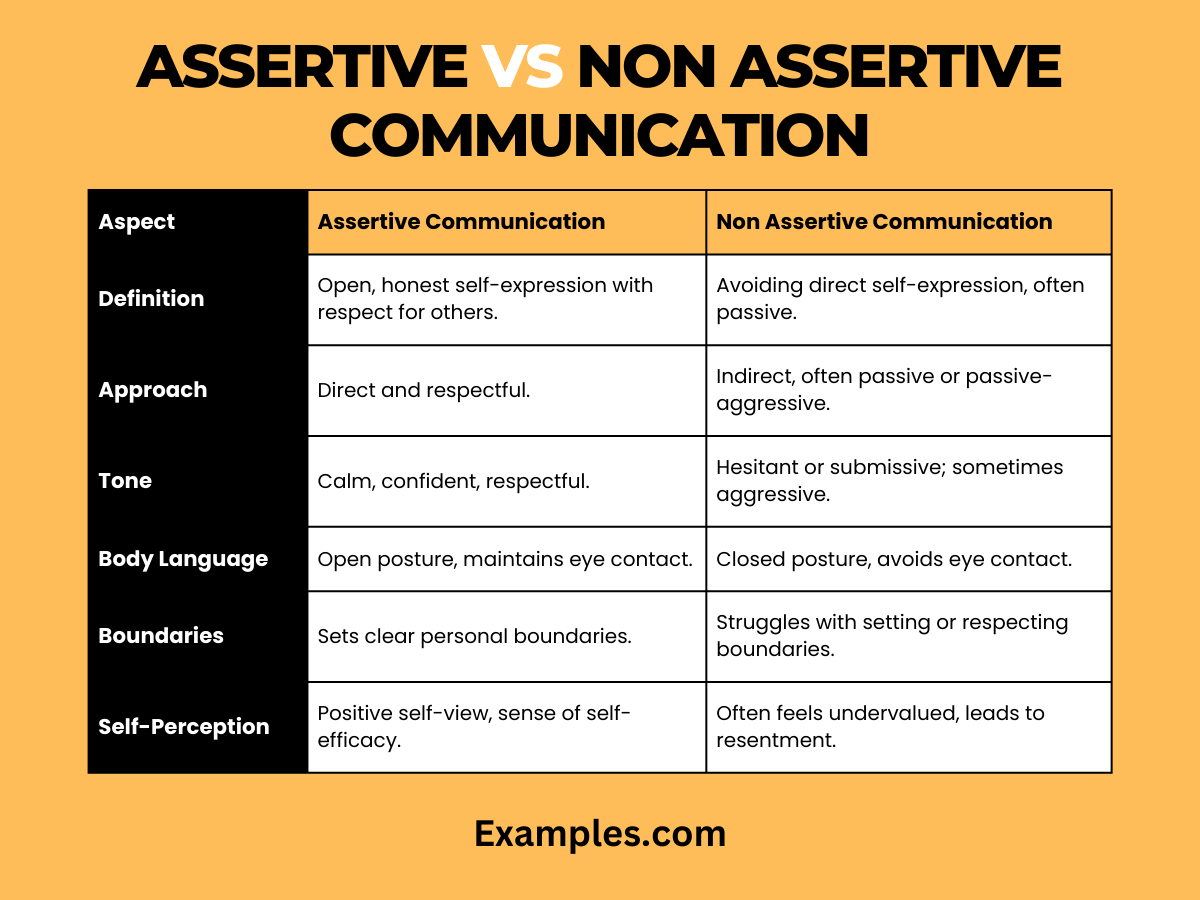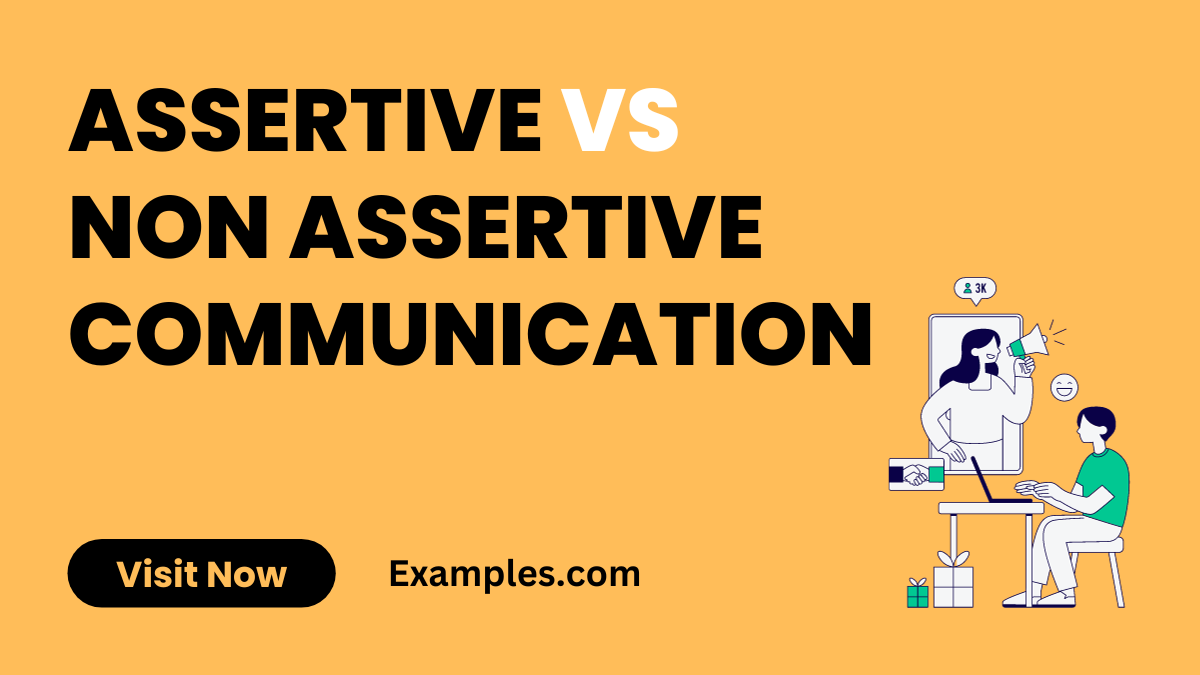Assertive vs Non Assertive Communication – 19+ Examples
“Welcome to the comprehensive guide on ‘Assertive vs Non Assertive Communication.’ This resource delves deep into the world of communication, offering a clear distinction between assertive and non-assertive styles. With practical Communication Examples, we provide insights into how each approach impacts interactions. Whether in professional settings or personal relationships, understanding these communication dynamics is crucial for effective dialogue. Learn through real-life examples how to harness the power of assertiveness and recognize the subtleties of non-assertive communication for improved connections and outcomes.”
Difference Between Assertive vs Non Assertive Communication
When exploring the distinction between assertive and non-assertive communication, it’s essential to understand how each style affects interaction and self-expression. Here, we present a detailed comparison in a table format, optimized for clarity and ease of understanding, especially focusing on “Assertive Communication.”

| Aspect | Assertive Communication | Non Assertive Communication |
|---|---|---|
| Definition | Involves expressing oneself openly and honestly, while maintaining respect for others’ opinions and rights. | Characterized by avoiding direct expression, leading to passive or indirect communication, and sometimes aggressive outbursts. |
| Approach | Direct, honest, and balanced, focusing on both the speaker’s needs and the listener’s rights. | Indirect and often unclear, leading to messages that are either too passive or unintentionally aggressive. |
| Tone and Delivery | Calm and confident, with a respectful tone that promotes understanding. | May vary from hesitant and submissive to unpredictably aggressive, especially under stress. |
| Body Language | Demonstrates open and confident body language, including steady eye contact and relaxed posture. | Often closed or defensive body language, with minimal eye contact and a protective posture. |
| Emotional Expression | Emotions are expressed in a controlled, respectful manner, acknowledging one’s feelings without imposing them on others. | Emotions are either suppressed, leading to internal frustration, or not clearly expressed, causing confusion. |
| Feedback and Criticism | Welcomes constructive feedback and is willing to offer it in a constructive manner. | Often avoids giving or receiving feedback due to fear of confrontation or misunderstanding. |
| Conflict Resolution | Actively seeks mutually beneficial solutions, advocating for oneself while considering others’ perspectives. | Either avoids conflict, leading to unresolved issues, or capitulates quickly, ignoring personal needs. |
| Setting Boundaries | Clearly communicates personal limits in a respectful way, while acknowledging and respecting others’ boundaries. | Struggles with setting and maintaining personal boundaries, leading to either overstepping or being overrun by others. |
| Impact on Relationships | Fosters trust, respect, and open communication, leading to healthier and more fulfilling relationships. | Can lead to misunderstandings, unexpressed resentments, and a lack of trust or intimacy in relationships. |
| Self-Perception | Encourages a positive self-view and a sense of self-efficacy, contributing to higher self-esteem. | Often leads to negative self-perceptions, feelings of powerlessness, or a sense of being undervalued. |
20 Examples of Assertive vs Non Assertive Communication
Assertive communication is key to effective and respectful interactions, marked by confidence and clarity, while non-assertive communication often leads to misunderstandings or passive behavior. Understanding the difference between these styles is crucial for personal and professional growth. Here are 20 unique examples showcasing the contrast between assertive and non-assertive communication, each with a brief explanation and a practical example.

- Requesting a deadline extension
Assertive: “I need an extension on this project to ensure quality work. Can we discuss a feasible timeline?”
Non-Assertive: “I’m not sure I can do this. Maybe I need more time?” - Declining an invitation
Assertive: “Thank you for the invite, but I can’t attend due to prior commitments.”
Non-Assertive: “I might be busy that day, I’m not sure.” - Asking for a raise
Assertive: “I would like to discuss my performance and the possibility of a salary review based on my contributions.”
Non-Assertive: “I don’t know if you think I deserve more, but I feel I work hard.” - Addressing a mistake
Assertive: “I realized I made an error in the report. I am correcting it and will ensure it doesn’t recur.”
Non-Assertive: “Maybe there’s a mistake in the report. I don’t know, maybe it’s not too bad?” - Giving feedback
Assertive: “Your presentation had great content. Including more data analysis could make it even stronger.”
Non-Assertive: “It was good, I guess. Maybe you could add something else?” - Handling unfair treatment
Assertive: “I feel that I have been treated unfairly in this situation. Can we discuss it?”
Non-Assertive: “It’s probably nothing, but I sometimes feel a bit left out.” - Expressing disagreement
Assertive: “I understand your point, but I have a different perspective. Let’s explore this further.”
Non-Assertive: “Well, I’m not sure, but maybe there’s another way to see it?” - Requesting help
Assertive: “Can you assist me with this task? Your expertise would be very helpful.”
Non-Assertive: “I don’t want to bother you, but I might need some help, maybe.” - Discussing a sensitive topic
Assertive: “This is a difficult topic, but it’s important we address it openly and respectfully.”
Non-Assertive: “I don’t know if we should talk about this. Maybe it’s not a good idea.” - Responding to criticism
Assertive: “Thank you for the feedback. I’ll reflect on it and see how I can improve.”
Non-Assertive: “I guess I’m just not good at this.” - Addressing a conflict
Assertive: “We seem to have a misunderstanding. Let’s clear it up and move forward.”
Non-Assertive: “It’s probably nothing. Let’s just forget about it.” - Sharing ideas in a meeting
Assertive: “I have an idea that might help. Here’s what I suggest…”
Non-Assertive: “This might be silly, but I was thinking, maybe, we could try…” - Setting personal boundaries
Assertive: “I value our work relationship, but I need to keep work and personal life separate.”
Non-Assertive: “I don’t really like talking about my personal life, but it’s okay, I guess.” - Negotiating a compromise
Assertive: “Let’s find a middle ground that respects both of our needs.”
Non-Assertive: “Whatever you think is best. I can adjust.” - Responding to a request
Assertive: “I understand your need, but I’m unable to commit to this request at the moment.”
Non-Assertive: “I’m not sure I can do that, but I’ll try, maybe.” - Asking for clarification
Assertive: “I’m not clear on this point. Could you please elaborate?”
Non-Assertive: “This might be a dumb question, but I’m a bit confused.” - Handling interruptions
Assertive: “I’d like to finish my point before we move on to the next topic.”
Non-Assertive: “Sorry, were you saying something important?” - Proposing a solution
Assertive: “Based on our discussion, I propose the following solution…”
Non-Assertive: “I’m not sure, but maybe we could try this?” - Expressing personal needs
Assertive: “For me to perform my best, I need a bit more information on this.”
Non-Assertive: “I might need more info, but it’s probably not important.” - Responding to a compliment
Assertive: “Thank you, I appreciate your acknowledgment of my work.”
Non-Assertive: “Oh, it was nothing, anyone could have done it.”
Comparison between Assertive vs Non Assertive Communication
Understanding the distinction between assertive and non-assertive communication is fundamental in honing interpersonal skills. Assertive communication strikes a balance between expressing one’s own needs and respecting others’, while non-assertive communication often falls into patterns of passivity or indirectness. This guide presents a detailed comparison of these two communication styles in a table format, with a focus on optimizing for “Assertive Communication.”
| Feature | Assertive Communication | Non Assertive Communication |
|---|---|---|
| Goal | To express one’s opinions and needs clearly while respecting others’. | To avoid conflict or to express oneself indirectly to prevent direct confrontation. |
| Tone | Confident and respectful, maintaining a calm demeanor. | Often timid, hesitant, or sometimes overly passive or aggressive. |
| Body Language | Open and relaxed, maintaining appropriate eye contact. | Closed or submissive, often avoiding eye contact or displaying nervous gestures. |
| Emotional Expression | Emotions are expressed openly but in a controlled manner. | Emotions are either suppressed or expressed in an uncontrolled way. |
| Verbal Expression | Clear, concise, and direct without being aggressive. | Vague, ambiguous, or overly passive in language and tone. |
| Listening Skills | Active listening with feedback that shows understanding and empathy. | Passive listening, often with minimal engagement or understanding. |
| Conflict Resolution | Seeks mutually beneficial solutions, open to discussion and compromise. | Avoids conflict or concedes without asserting personal needs or opinions. |
| Feedback Approach | Provides constructive feedback and is open to receiving it. | Avoids giving feedback or becomes defensive when receiving it. |
| Self-Perception | Often feels empowered and confident in their ability to communicate effectively. | May feel powerless, unheard, or anxious about expressing themselves. |
| Impact on Relationships | Generally leads to healthy and respectful relationships. | Can lead to misunderstandings, unresolved issues, and resentment in relationships. |
What is the Relationship Between Assertive vs Non Assertive Communication?
The relationship between assertive and non-assertive communication is fundamental in shaping how individuals interact with each other. Assertive communication is characterized by a balanced, respectful, and confident approach to expressing oneself, which not only bolsters self-esteem but also enhances the quality of relationships. Non-assertive communication, which can be either passive or aggressive, often results in misunderstandings, reduced self-esteem, and strained relationships. This expanded comparison table offers deeper insights into the unique attributes and impacts of both styles.
| Assertive Communication | Non Assertive Communication |
|---|---|
| Direct and honest expression of thoughts and feelings. | Indirect, unclear, or suppressed expression of thoughts and feelings. |
| Typically boosts self-esteem and confidence. | Often leads to diminished self-esteem and a sense of inadequacy. |
| Proactively addresses and resolves conflicts. | Tends to avoid conflicts or addresses them in a passive manner. |
| Fosters trust, respect, and healthy relationships. | Can result in misunderstandings, lack of trust, and unhealthy dynamics in relationships. |
| Welcomes constructive feedback and handles it maturely. | Avoids direct feedback and may respond to criticism defensively. |
| Engages actively and confidently in decision-making. | Frequently defers decisions to others or avoids making decisions. |
| Clearly communicates personal boundaries and respects others’. | Struggles with setting or respecting personal and others’ boundaries. |
| Appropriately and respectfully expresses emotions. | Emotions are often expressed inappropriately or not at all. |
| Positively influences group dynamics and morale. | May negatively impact group dynamics and lower morale. |
| Employs a proactive and collaborative approach to problem-solving. | Often relies on others for problem-solving or adopts a passive approach. |
I was unable to find a working link from the American Psychological Association specifically related to assertiveness. However, I can suggest an alternative authoritative source for assertiveness-related content. The University of California, Berkeley’s Greater Good Science Center offers a wealth of information on various psychological and interpersonal topics, including assertiveness. You might find their article on assertiveness valuable for providing insights and practical advice. Here’s the link to the Greater Good Science Center’s main page: Greater Good Science Center.
For another reputable source, Psychology Today offers a range of articles and resources on assertiveness, which can be beneficial for understanding and applying assertive communication in different contexts. Here’s the link to Psychology Today’s homepage: Psychology Today.



